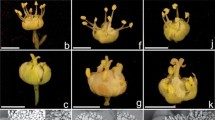Abstract
We studied the floral and pollination biology of Amomum maximum. Our observations suggest that flexistyly is present in this species, and stigmatic behavior is similar as reported for Alpinia species. Two phenotypes occur in a ratio of 1:1 in natural populations. No fruit set occurred in the unpollinated bagged plants. Significant differences in seed set between selfing and crossing manipulations demonstrate that inbreeding depression or partial self-incompatibility is apparent in this species. Despite the resemblance in floral behavior, there are still some differences between the previous studies and ours: with special floral design, the body size of legitimate visitors ranged wider in Amomum maximum than in Alpinia species; the presence of anther appendage is suggested to prevent competing and delayed selfing. This is the first report of flexistyly in a wild cardamom species, which is the second largest group in ginger family (Zingiberaceae).
Similar content being viewed by others
References
Barrett S. C. H. (2002). The evolution of plant sexual diversity. Nat. Rev. Genet. 3: 273–284
Charlesworth B. and Charlesworth D. (1987). A model for the evolution of dioecy and gynodioecy. Amer. Naturalist 112: 975–997
Charlesworth B. and Charlesworth D. (1999). The genetic basis of inbreeding depression. Genet. Res. 74: 329–340
Cruden R. W. (1977). Pollen-ovule ratios: a conservative indicator of breeding system in flowering plants. Evolution 31: 32–46
Cui X.-L., Wei R.-C., Huang R.-F. (1995) A preliminary study on genetic system of Amomum tsao-ko. Journ. of Yunnan Univ. (Nat. Sci.). 17: 290–297 (in Chinese with English abstract).
Cui X.-L., Wei R.-C., Huang R.-F. (1996) A study on the breeding system of Amomum tsao-ko. Proceedings 2nd Symp. Fam. Zingiberaceae. 1996: 288–296, South China Institute of Botany.
Darwin C. (1876). The effects of cross and self fertilization in the vegetable kingdom. Murray, London
Feng Z.-L., Zheng Z., Zhang J.-H., Cao M., Sha L.-Q. and Deng J.-W. (1998). Biomass and its allocation of a tropical wet seasonal rain forest in Xishuangbanna. Acta Phytoecol. Sin. 22: 481–488
Kress W. J., Liu A.-Z., Newman M. and Li Q.-J. (2005). The molecular phylogeny of Alpinia (Zingiberaceae): a complex and polyphyletic of gingers. Amer. J. Bot. 92: 167–178
Kress W. J., Prince L. M. and Williams K. J. (2002). The phylogeny and a new classification of the gingers (Zingiberaceae): Evidence from molecular data. Amer. J. Bot. 89: 1682–1696
Li Q.-J., Xu Z.-F., Kress W. J., Xia Y.-M., Zhang L., Deng X.-B., Gao J.-Y., Bai Z.-L. (2001a) Flexible style that encourages outcrossing. Nature 410: 432.
Li Q.-J., Xu Z.-F., Kress W. J., Xia Y.-M., Zhang L., Deng X.-B., Gao J.-Y. (2001b) Study on the flexistyly pollination mechanism in Alpinia plants (Zingiberaceae). Acta Bot. Sin. 43: 346–369 (in Chinese with English abstract).
Li Q.-J., Kress W. J., Xu Z.-F., Xia Y.-M., Zhang L., Deng X.-B. and Gao J.-Y. (2002). Mating system and stigmatic behaviour during flowering of Alpinia kwangsiensis (Zingiberaceae). Pl. Syst. Evol. 232: 123–132
Pannell R. J., Dorken E. M. and Eppley M. S. (2005). `Haldane's Sieve' in a metapopulation: sifting through pl. reproductive polymorphisms. Trends Ecol. Evol. 20: 374–379
Pedersen L. B. (2004). Phylogenetic analysis of the subfamily Alpinioideae (Zingiberaceae), particularly Etlingera Giseke, based on nuclear and plastid DNA. Pl. Syst. Evol. 245: 239–258
Renner S. S. (2001). How common heterodichogamy. Trends Ecol. Evol. 16: 595–597
Sakai S., Kato M. and Inoue T. (1999). Three pollination guides and variation in floral characteristics of Bornean gingers (Zingiberaceae and Costaceae). Amer. J. Bot. 86: 646–658
Schumann K. (1904). Zingiberaceae. In: Engler, A. (eds) Das Pflanzenreich. IV, 46, pp 1–458. W. Engelmann, Leipzig
Takano A., Gisil J., Yusoff M. and Tachi T. (2005). Floral and pollinator behaviour of flexistylous Bornran ginger, Alpinia nieuwenhuizii (Zingiberaceae). Pl. Syst. Evol. 252: 167–173
Wang Y.-Q., Zhang D.-X. and Chen Z.-Y. (2004). Pollen histochemistry and pollen: ovule ratios in Zingiberaceae. Ann. Bot. 94: 583–591
Wu T.-L. and Larsen K. (2000). Zingiberaceae. In: Wu, Z.-Y. and Raven, P. H. (eds) Flora of China. Vol. 24, pp 322–377. Science Press, Beijing and Missouri Botanical Garden, St. Louis
Xia Y.-M., Kress W. J. and Prince L. M. (2004). Phylogenetic analyses of Amomum (Alpinioideae: Zingiberaceae) using ITS and matK DNA sequence data. Syst. Bot. 29: 334–344
Zhang D.-Y. (2004). The evolution of plant life history and reproductive ecology. Science Press, Beijing (in Chinese)
Zhang L., Li Q.-J., Deng X.-B., Ren P.-Y. and Gao J.-Y. (2003). Reproductive biology of Alpinia blepharocalyx (Zingiberaceae): another example of flexistyly. Pl. Syst. Evol. 241: 67–76
Zhang L. and Li Q.-J. (2002). Flexistyly and its evolutionary ecological significance. Acta Phytoecol. Sin. 26: 385–391 (in Chinese with English abstract)
Author information
Authors and Affiliations
Corresponding author
Rights and permissions
About this article
Cite this article
Ren, PY., Liu, M. & Li, QJ. An example of flexistyly in a wild cardamom species (Amomum maximum (Zingiberaceae)). Plant Syst. Evol. 267, 147–154 (2007). https://doi.org/10.1007/s00606-007-0554-x
Received:
Accepted:
Published:
Issue Date:
DOI: https://doi.org/10.1007/s00606-007-0554-x




